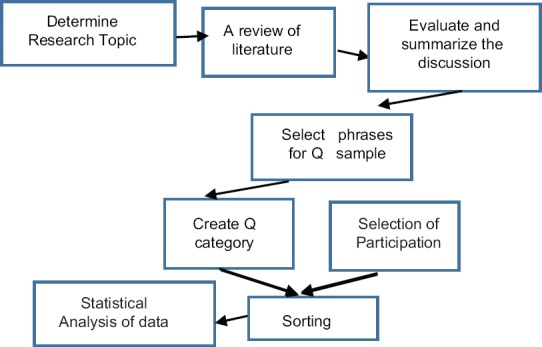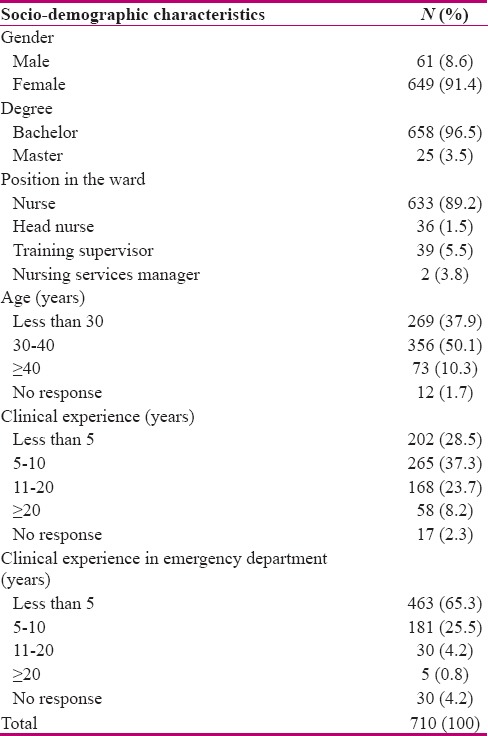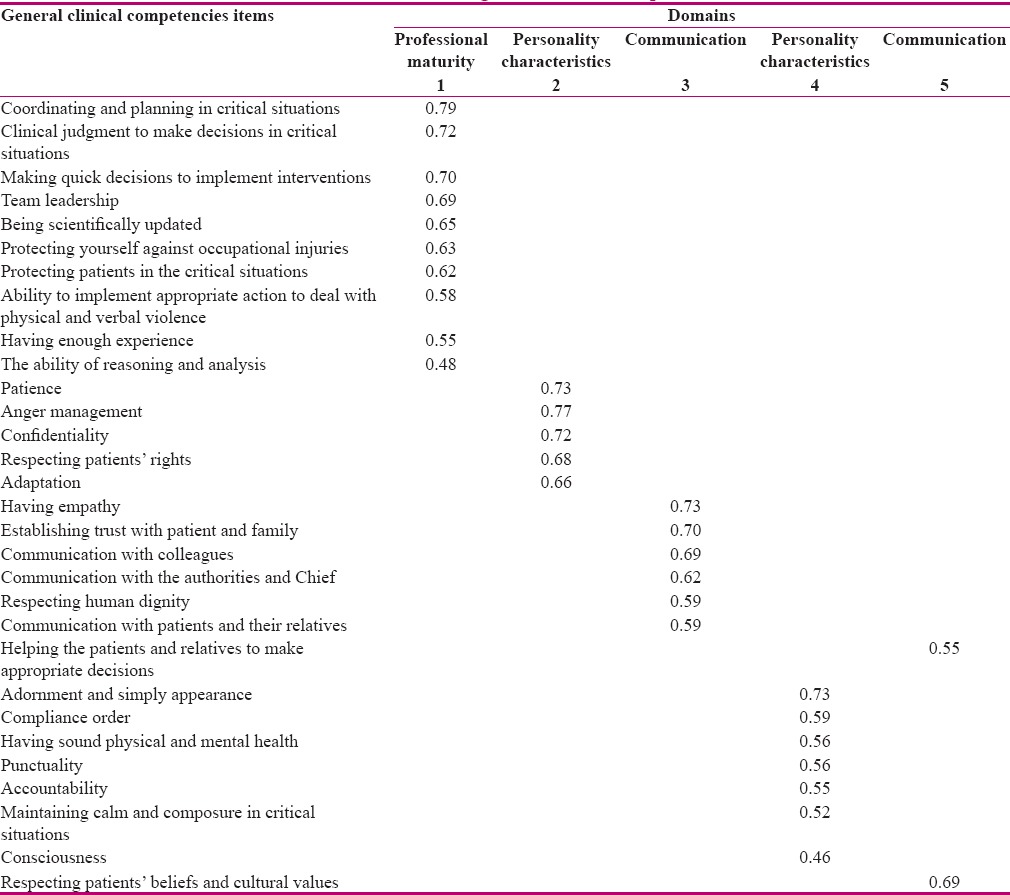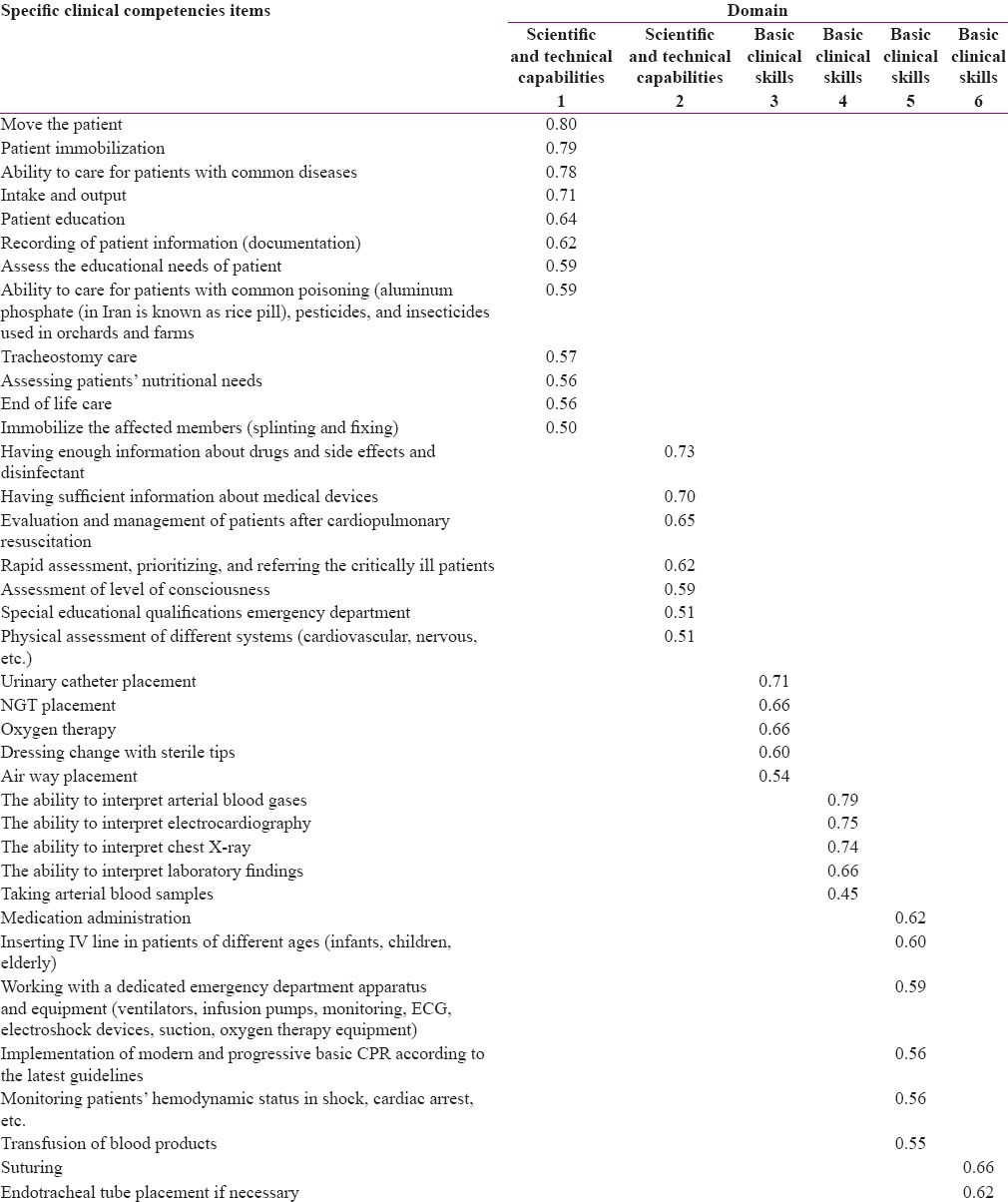Abstract
Background:
Nursing as a clinical discipline is developing in the emergency wards. Health care systems should continuously assess and prioritize indicators of clinical competency in these wards. The lack of clear standards of clinical competency indicators challenges evaluation. The purpose of this study was to determine clinical competency indicators and its priority based on nurses' views in educational and therapeutic centers in Guilan.
Materials and Methods:
The Q methodology was conducted in three phases, that is, phase I (determining the clinical competency indicators), phase II (classifying clinical competency indicators by an expert panel), and phase III (prioritizing clinical competency indicators). The subjects were selected by convenience sampling among nurses working in the emergency wards of teaching hospitals affiliated to Guilan in 2013. Finally, clinical competency indicators were prioritized using exploratory factor analysis.
Results:
In the prioritizing phase, data were collected from 710 nurses over two months. Five factors with 30 general competencies were found in three domains: communication, professional maturity, and personality characteristics. Six factors with 37 specific competencies were also found in two domains: scientific and technical capabilities and basic clinical skills that can provide a structured instrument for assessing clinical competence in emergency nurses.
Conclusions:
Achieved competencies can be used as a reference for nursing education and practice in emergency. Further research on health care system is needed in order to achieve a reliable and valid instrument.
Keywords: Clinical competence, emergency service, hospital, Iran, nursing staff
Introduction
Nurses are key members of healthcare system, and their clinical competency is crucially important, particularly in the emergency department. There is a close relationship between nurses' clinical competency and quality of care.[1,2] However, there is a lack of high quality studies on nurses' clinical competency criteria in the emergency departments.
In the context of continual changes in the medical technology and nurses' roles and responsibilities, it is important not only for nurses to maintain and develop their clinical competency but also for nurse managers to assess such competencies to ensure the quality and safety of care.[3,4] Given the extent of nurses' roles in different clinical areas, special instruments need to be developed for assessing nurses' clinical competence.[5] Then, these competencies can be used as clinical guidelines either in the evaluation or teaching and preparing specialized nurses in clinical settings such as emergency departments.[6]
Several factors are involved in the lack of using nursing knowledge and skills in practice. The barriers that prevent nurses to implement knowledge and expertise in the area of acute care and emergency nursing include lack of recognizing emergency nursing as a specialized care, lack of standards of clinical competency, and lack of specific instruments and indicators for assessing nurses' competency in emergency departments. Thus, it is necessary to develop not only standards of nursing competence in special areas, such as emergency nursing, but also appropriate instruments to assess these competencies.[3] Moreover, it is recommended that stakeholders (staff nurses and nurse managers) are involved in the process of developing such instruments in each specific area.[3,6]
If the standards of clinical competency are not clear, assessment of clinical competency will be difficult.[2,7] Clinical competencies can be divided into two categories of general and specific competencies. The general clinical competencies include adherence to professional values, good communication and management skills, ability to work in a team, providing primary healthcare, possessing basic medical sciences, and adopting basic cultural attributes. The specific competencies also include expertise in health or illness monitoring, assessing the quality of care, performance monitoring, and implementing specific procedures such as endotracheal intubation, airway management, patients management during cardiopulmonary resuscitation, and prevention of displacement of fractured bones.[6,8]
The Emergency Nurses Association (ENA) Nurse Practitioner (NP) Validation Work Team has identified 60 nursing competencies required for working in an emergency department.[6]
Using the Delphi technique, Witt and Almeida developed an instrument for identification of nurses' competencies. They divided the competencies into two broad categories of general and specific competencies.[8] Meretoja et al.[9] have also developed a scale for assessing nurses' competence. Ramirez et al.[10] developmed an insrtument for assessing nurse practitioner treatment competencies in emergency care settings. They performed a factor analysis and excluded some items (tasks), such as “assisting family members to cope with end-of-life issues,” “insertion of central and peripheral lines,” and “performing interventions that utilize technological devices to sustain physiologic function (e.g., intubation),” from the final instrument.[10]
There are not checklists for assessing Iranian nurses' competencies in different clinical settings including emergency departments regardless of environmental, technological, and cultural factors. Nurses are ethically and professionally obliged to provide high quality care in all healthcare settings, especially in emergency departments. In addition, it is necessary to evaluate nurses' competencies to ensure that optimal care is being delivered to patients. Such practice requires reliable methods and indigenous instruments to be implemented. However, few reliable instruments are available to assess nurses' professional competency in the area of emergency care. This study aimed to determine clinical competency indicators to develop an instrument for assessing nurses' professional competency in the emergency care. Such an instrument could be used as an evaluation tool and guideline by nurses for development of attributes and skills required for making clinical decisions. It could also be used as a step toward professional development and further specialization in emergency nursing.
Materials and Methods
This study was conducted using the Q method. The Q methodology was developed by William Stephenson–a British physicist-psychologist –in 1935.[11] It is often associated with quantitative analysis because of its involvement with factor analysis. Q methodology “combines the strengths of both qualitative and quantitative research traditions” and in other respects provides a bridge between the two.[11] Figure 1 shows the process of implementing Q-methodology in the present study.
Figure 1.

Steps of Q-methodology study
This study was conducted in three stages. In the first and second stages, a qualitative method, and in the third stage, a quantitative method was used. The inclusion criteria were permanent or contracted nurses with a history of working in the emergency department.
In the first stage, data were collected using a questionnaire. The questionnaire was developed through literature review; content validity was performed by 15 faculty members in Shahid Beheshti Nursing and Midwifery School. The questionnaire comprised two parts. The first part consisted of items on nurses' age, gender, level of education, position in the ward, time worked in the emergency department, the type of the emergency department, and present working unit. The second part consisted of open-ended questions asking participants to list the indicators of emergency nurses' clinical competency. A total of 50 nurses participated in this stage.
In the second stage, the list of emerged indicators was reviewed, discussed, April-May 2014 edited, and categorized by a panel of 21 experts including 10 experienced emergency nurses, seven nurse educators, two specialists in emergency medicine and two nurse managers. Finally, 71 items were derived and included in a questionnaire. The questionnaire was sent to a sample of nurses; they were asked to rank each item from 1 to 5, according to its priority.
Sample size for item analysis was calculated according to the number of items. According to Munro[12] at least 10 samples per item are needed to perform factor analysis and generalize the findings. 10 samples per item were selected in this study. Then, 710 participants were selected among nurses who were in third stage, June-July 2014 working in the emergency departments of educational hospitals affiliated with Guilan University of Medical Sciences.
Descriptive statistics including mean and standard deviation (SD) were used to analyze personal and social characteristics of the sample. Exploratory factor analysis was carried out using the Statistical Package for the Social Sciences version 18 (SPSS,18 software package). Extraction method of principal components was used to extract the final items that represent the final indicators.
Initially, a correlation matrix was formed from items related to the general clinical competency. The correlation between the variance of variables should not be less than 0.5 for each variable. The Kaiser–Meyer–Oklin (KMO) test was performed to confirm the sampling adequacy. The principal component analysis method was used to assess the priorities of the clinical competence indicators. All factors related to the clinical competency were entered into the factor analysis. Then, the rotation of Varimax was used to extract the possible factors in the questionnaire. Reviewing the table of communalities and based on the rotated component matrix and the complex structure condition, all items with factor loadings less than or equal to 0.4 were removed in four stages. Therefore, 30 items related to the general competencies were included and specific competencies–which had low correlations with other items and would decrease the predictive power of the model–were removed. Thus, in the first phase the item “having enough information about emergency situations,” in the second step the item “assessment of patients who use high-risk medication,” in the third phase the item “caring for a chest tube,” and in the fourth stage the item “caring for a central venous catheter” were removed from the instrument. Finally, 6 factors including 37 items (which were the indicators for competence in emergency nursing) remained in the instrument. Then, the 6 factors extracted through the exploratory model were labeled.
In factor analysis of the general clinical competencies, the KMO test was performed to confirm the sample adequacy, which was 0.96. Moreover, the Bartlet's test of sphericity was performed to confirm the appropriateness of the correlation matrix, which was 12509.96 (P = 0.001). In addition, the value of KMO and Bartlet's sphericity tests for specific clinical competencies were 0.95 and 16939.66, respectively (P = 0.001). The values above 0.7 for the KMO test and the statistical significance of the Bartlet's test indicate sampling adequacy to perform factor analysis.[10] In this study, the KMO value was more than 0.7, which indicated that factor analysis was appropriate for the data.
Ethical considerations
This research project was registered at Guilan University of Medical Sciences with code: IR.GUMS.REC.1394.381 in 2014. Necessary introduction letters were obtained from the university, and written informed consent forms from the study performers. Subjects were assured regarding the confidentiality.
Results
The majority of the sample were female nurses (91.4%); 96.5% of them had bachelor's degree and 89.2% of them were at the position of the ward nurse. Approximately half of the samples were aged between 30 and 40 years, 37.3% of nurses had 5–10 years of clinical experience and 65.5% of them had experience in the emergency department of less than 5 years. The participants' socio-demographic characteristics are summarized in Table 1.
Table 1.
Distribution of the participants according to socio-demographic characteristics in the third stage

The distribution of cumulative variance after Varimax rotation showed that only 5 factors, which consisted of 30 items, can predict 63.77% of the total variance of indicators of general clinical competence. The Scree plot of general clinical competence indicators showed that only 5 factors out of 30 existing factors had an Eigenvalue more than 1 and can be used as predictors for general clinical competence. The final rotated matrix of general clinical competence indicators showed that five factors consisted of 30 items with higher levels of predictability, according to the nurses point of view [Table 2].
Table 2.
Final rotated matrix of general clinical competence indicators

In the factor analysis of specific clinical competencies, the distribution of cumulative variance after Varimax rotation showed that only six factors (which consisted of 37 items) can predict 65.90% of the total variance of indicators of specific clinical competence.
The Scree plot of specific clinical competence indicators showed that only 6 factors out of 37 existing factors had an Eigenvalue more than and can be predictive of specific clinical competence. The final rotated matrix of specific clinical competence indicators showed that the six factors consisted of 37 items with higher levels of predictability, according to the nurses point of view [Table 3].
Table 3.
Final rotated matrix of specific clinical competence indicators

Discussion
Assessment of nurses' professional competencies has a critical role in professional promotion. Because nurse managers should regularly evaluate nurses' clinical competency, the instrument designed in this study may facilitate the process of assessment of emergency nurses' general and specific clinical competence. Nurses' involvement in the crisis and unexpected events and performing the predetermined duties is consistent with the domain of “professional maturity” in checklists currently being used to assess the nurses' competencies in Iran.[12] Witt and Almeida developed an instrument for identification of nurses' competencies using the Delphi technique. They divided nurses' competencies into two broad categories of general and specific competencies.[8] The domains of “formulating and implementing nursing care plans,” “professional values” and “teamwork” in this study are compatible with some domains of the checklist designed by Witt and Almeida. However, Meretoja et al.[13] have also developed a scale for assessing nurses' competency. They introduced a “helping role” as an important nursing duty.[9] This role overlaps with the item “helping the patient and relatives to make appropriate decisions” in the present study. They have also emphasized on nurses' role in “coordinating” and “prioritizing caring interventions in a flexible manner” and placed them in the domains of “theraputic interventions” and “job duties.” These roles are compatible with some items in the domain of “professional maturity” and “personality characteristics of nurses in emergency department” in the present study.
Similar to the current study, “being scientifically updated” emerged as a criterion of professional competency in a study by Safadi et al.[14] Khomeiran et al.[15] also reported that experienced nurses are more likely to convert theoretical knowledge into clinical practice.
Safadi et al.[14] showed that job-personality compatibility is an important factor in professional success. This is especially important for nurses when they are selected to be employed in emergency departments. Nurses in emergency departments are frequently encountered with unpredictable conditions and patients' and relatives' angers and agressions. While manegers are responsible to support nurses during callenging situations, it is important for nurses to be able to control their anger. Attending some courses on anger management may also be helpful to prepare nurses in this regards.
Nurses' work conscience refers to nurses' accountability toward performing the best possible care. It has been shown that nurses' feeling of being responsible would induce a sense of power and authority and motivate them to implement their knowledge and skills to do their best for their patients.[15,16]
“Effective communication” is another domain in the checklist designed in this study. Lofmark and Liu[17,18] have also developed instruments for assessing nurses' professional competence. Communication was an important criterion in both of these instruments. The crucial importance of effective communication has also been emphasized as the “core competency for nurse licensing exam,”[19] an indicator for nurses' clinical competence,[16] as well as an important factor in patients and their families' satisfaction.[14]
Effective communication is an important factor in the process of professionalization. Nursing is a profession, therefore acquiring and implementing high levels of communication skills is a core competency and is required for all nurses,[2] especially for those working in emergency departments. Nurses who possess higher levels of professional knowledge and implement it through effective communication, gain credibility, and experience a sense of empowerment. Such nurses are more able to intervene based on their diagnosis and influence others.[20]
“Respecting patients' beliefs and cultural values” is one of the items on the checklist designed in this study. Nikpeyma and Ashktorab emphasized the importance of this ability. Developing the ability of effective communication with patients from different cultural backgrounds is a core nursing competency and a lifelong professional goal, which facilitates nurse–patient therapeutic relationships.[21] To reudce the problems caused by nurse–patient cultural differences, some Iranian authorities insist that nurses should be a native of the city where they are working.[16] Guilan is a province with several subcultures and dialects. It also is adjacent with provinces of Ardebil and Mazandaran. Then, hospitals in Guilan may admit patients from different subcultures, and therefore, nurses working in these hospitals should be familiar with several subcultures.
The item “rapid assessment, prioritizing, and referral critically ill patients” in this instrument is compatible with the “prioritizing patient care” and “crisis management” in the instruments designed by Safadi et al. and Meretoja et al., respectively.[9,14] Appropriate patient assessment and possessing a high level of knowledge in this regard were also cited as core nursing competencies by Gardner et al.[22] and Khomeiran et al.[16] However, as Nesami reported, having knowledge might not directly affect people's behavior or performance,[2] but some internal drives and external forces, support, and supervision are also needed. Moreover, an efficient in-service and continual education system may act as an external factor in the enhancement of nurses' clinical competence.[16]
Ramirez et al.[10] also developed an instrument for assessing nurse practitioner competencies in emergency care settings. They performed a factor analysis and excluded some items such as “assisting family members to cope with end-of-life issues,” “insertion of central and peripheral lines,” and “performing interventions that utilize technological devices to sustain physiologic function (e.g., intubation)” from the final instrument.[10] This finding may be attributed to the contents of the nursing curriculum or to legal liabilities arising due to a wrong interpretation. It appears that the emergency nurses require special knowledge and expertise.
According to Gardner et al.,[22] direct comprehensive care consists of competencies such as expertise in diagnostic testing, documenting, efficient movement of patient, and patient and family education. In a recent study, Lock[19] used the Delphi method to select examinable nursing core competencies. The final list consisted of competencies on implementing nosocomial infection control principles; measuring the vital signs; analyzing, interpreting, and documenting data accurately; facilitating oxygen needs; facilitating electrolyte and liquid needs; conducting wound treatment; giving medicine in a safe and appropriate way; and managing blood or its products safely.[19] Moreover, using the Delphi method, the ENA NP Validation Work Team has identified 60 nursing competencies required for working in an emergency department.[6]
In the present study, the following items were removed from the final competency list: “Having sufficient information on emergency situations,” “assessment of patients who use high-risk medications,” “caring for a chest tube,” and “caring for a Central Venous Catheter (CVC),” whereas some of them are among the competencies in checklists currently being used to assess the nurses' competencies in Iran.[13] Exclusion of the items “having sufficient information on emergency situations” and “caring for a CVC” may be attributed to the fact that patients usually have not a long-term stay in the emergency departments. Most emergency departments in the Guilan province do not have a large number of beds, are overcrowded, are not specialized departments, and provide some preliminary medical care. If patients need specialized medical care, they would be transported to the specialized hospitals in the center of the province. Then, nurses in most emergency departments feel that they do not need to possess specific knowledge regarding complicated emergency situations. Perhaps one of the main limitations of the study was the lack of accurate identification of the experts due to the limited time of the present master's thesis project.
Conclusion
Nursing as a clinical discipline is developing day to day and nurses are involved as a key member in various environments including emergency wards. Nurses must maintain their professional competence, and to improve the health care system, they must continuously evaluate and prioritize their clinical competence indicators. Evaluation of clinical competence is difficult because of the lack of clear standards. This study suggested that similar studies have been conducted in other areas and specialized emergency departments. Moreover, it is suggested that the instrument designed in the present study be used in future studies. In doing so, its reliability and appropriateness would extensively be assessed. In addition, comparative studies may be suggested to investigate the differences between the checklists currently being used and the list of competencies developed in the present study. Moreover, a qualitative study is suggested to assess physicians' views on the criteria for emergency nurses clinical competence.
Financial support and sponsorship
This article is drived from a MSc thesis that was supported by Guilan University of Medical Sciences.
Conflicts of interest
There are no conflicts of interest.
Acknowledgement
The authors are deeply thankful for the cooperation and support received from Giulan's general office of nursing, all supervisors and nurses in emergency departments, and all who participated in this study. This research was registered with number 90213 in Guilan University of Medical Sciences.
References
- 1.Mahmoudi H, Ebadi A, Salimi SH, Najafi Mehri S, Mokhtari Noori J, Shokrollahi F. Effect of nurse communication with patients on anxiety, depression and stress level of emergency ward patients. Iranian J Crit Care Nurs. 2010;3:3–4. [Google Scholar]
- 2.Nesami M, Rafiee F, Parvizi S, Esmaeili R. Concept analysis of competency in nursing: Qualitative research. J Mazandaran Univ Med Sci. 2008;18:35–42. [Google Scholar]
- 3.Bahreini M, Moattari M, Kaveh MH, Ahmadi F. A comparison of nurses' clinical competences in two hospitals affiliated to Shiraz and Boushehr Universities of Medical Sciences: A self-assessment. Iran J Med Educ. 2010;10:101–10. [Google Scholar]
- 4.Lenburg CB, Klein C, Abdur-Rahman V, Spencer T, Boyer S. The COPA model: A comprehensive framework designed to promote quality care and competence for patient safety. Nurs Educ Perspect. 2009;30:312–7. [PubMed] [Google Scholar]
- 5.Ghalje M, Ghaljae F, Mazlum A. Association between clinical competency and patient's satisfaction from nursing care. J Nurs Midwifery. 2008;18:12–9. [Google Scholar]
- 6.ENA NP Validation Work Team. Hoyt KS, Coyne EA, Ramirez EG, Peard AS, Gisness C, et al. Nurse Practitioner Delphi Study: Competencies for practice in emergency care. J Emerg Nurs. 2010;36:439–49. doi: 10.1016/j.jen.2010.05.001. [DOI] [PubMed] [Google Scholar]
- 7.Scott Tilley DD. Competency in nursing: A concept analysis. J Contin Educ Nurs. 2008;39:58–64. doi: 10.3928/00220124-20080201-12. [DOI] [PubMed] [Google Scholar]
- 8.Witt RR, de Almeida MC. Identification of nurses' competencies in primary health care through a Delphi study in southern Brazil. Public Health Nurs. 2008;25:336–43. doi: 10.1111/j.1525-1446.2008.00714.x. [DOI] [PubMed] [Google Scholar]
- 9.Meretoja R, Isoaho H, Leino-Kilpi H. Nurse competence scale: Development and psychometric testing. J Adv Nurs. 2004;47:124–33. doi: 10.1111/j.1365-2648.2004.03071.x. [DOI] [PubMed] [Google Scholar]
- 10.Ramirez EG, Tart K, Malecha A. Developing nurse practitioner treatment competencies in emergency care settings. Adv Emerg Nurs J. 2006;28:346–59. [Google Scholar]
- 11.Brown SR. Q methodology and qualitative research. Qual Health Res. 1996;6:561–7. [Google Scholar]
- 12.Munro BH. Statistical Methods for Health Care Research. Lippincott Williams and Wilkins; 2005. Available from: https://books.google.com . [Google Scholar]
- 13.Nursing Tasks. Tehran: Iranian Nursing Organization; 2016. Available from: http://ino.ir . [Google Scholar]
- 14.Safadi R, Jaradeh M, Bandak A, Froelicher E. Competence assessment of nursing graduates of Jordanian universities. Nurs Health Sci. 2010;12:147–54. doi: 10.1111/j.1442-2018.2009.00507.x. [DOI] [PubMed] [Google Scholar]
- 15.Khomeiran RT, Yekta ZP, Kiger AM, Ahmadi F. Professional competence: Factors described by nurses as influencing their development. Int Nurs Rev. 2006;53:66–72. doi: 10.1111/j.1466-7657.2006.00432.x. [DOI] [PubMed] [Google Scholar]
- 16.Memarian R, Salsali M, Vanaki Z, Ahmadi F, Hajizadeh E. Professional ethics as an important factor in clinical competency in nursing. Nurs Ethics. 2007;14:203–14. doi: 10.1177/0969733007073715. [DOI] [PubMed] [Google Scholar]
- 17.Lofmark A, Smide B, Wikblad K. Competence of newly-graduated nurses–A comparison of the perceptions of qualified nurses and students. J Adv Nurs. 2006;53:721–8. doi: 10.1111/j.1365-2648.2006.03778.x. [DOI] [PubMed] [Google Scholar]
- 18.Liu M, Kunaiktikul W, Senaratana W, Tonmukayakul O, Eriksen L. Development of competency inventory for registered nurses in the People's Republic of China: Scale development. Int J Nurs Stud. 2007;44:805–13. doi: 10.1016/j.ijnurstu.2006.01.010. [DOI] [PubMed] [Google Scholar]
- 19.Lock LR. Selecting examinable nursing core competencies: A Delphi project. Int Nurs Rev. 2011;58:347–53. doi: 10.1111/j.1466-7657.2011.00886.x. [DOI] [PubMed] [Google Scholar]
- 20.Hagbaghery MA, Salsali M, Ahmadi F. The factors facilitating and inhibiting effective clinical decision-making in nursing: A qualitative study. BMC Nurs. 2004;3:2. doi: 10.1186/1472-6955-3-2. [DOI] [PMC free article] [PubMed] [Google Scholar]
- 21.Nikpeyma N, Ashktorab T. Nurses' views about factors affecting the professional roles. J Health Promotion Manage. 2012;1:73–84. [Google Scholar]
- 22.Chang AM, Gardner GE, Duffield C, Ramis MA. Advanced practice nursing role development: Factor analysis of a modified role delineation tool. J Adv Nurs. 2012;68:1369–79. doi: 10.1111/j.1365-2648.2011.05850.x. [DOI] [PubMed] [Google Scholar]


